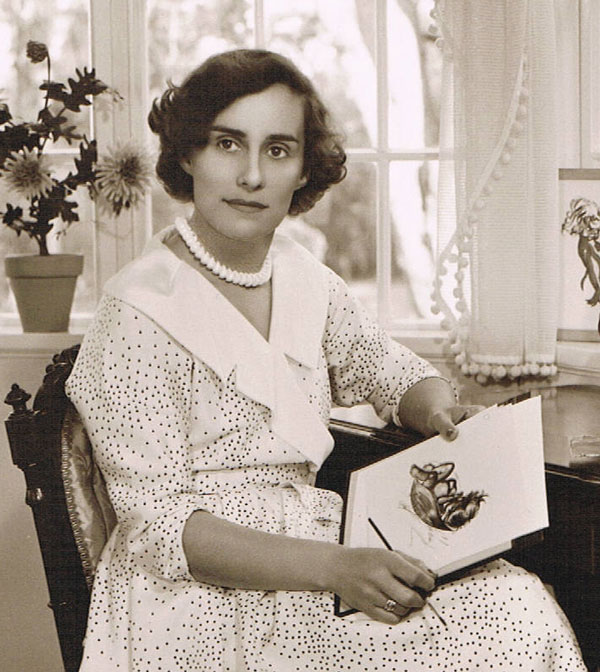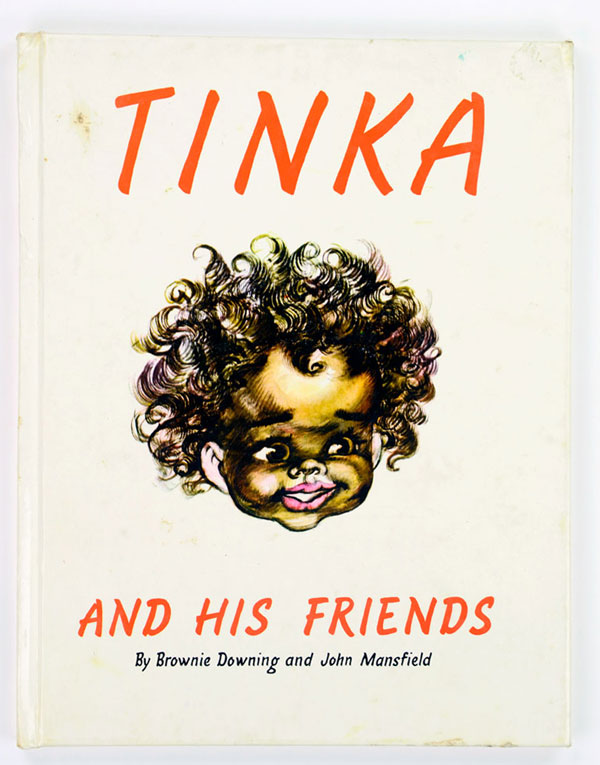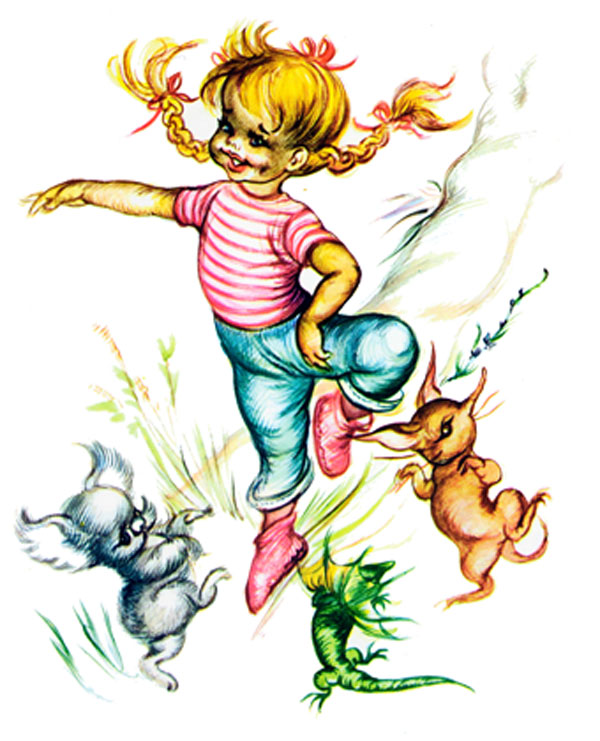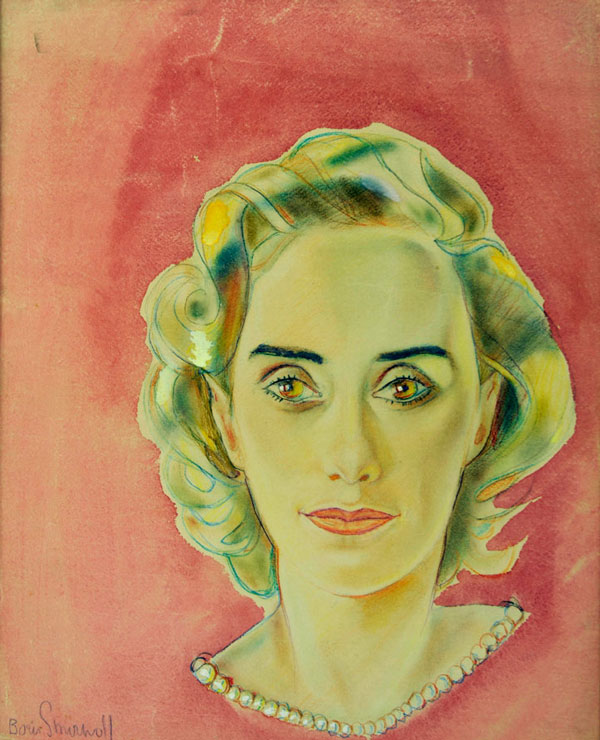Biography of Brownie Downing
Viola Edith “Brownie” Downing was born at Manly, Sydney in Australia on the 9th May 1924 and died at the age of 71 at her home in the mountain village of Pal in Andorra on the 16th May 1995.
She was an extraordinary woman who led an extraordinary life. Below is her Obituary taken from The Australian newspaper.
Artist Believed In The World’s Magic
18th July 1995 By: EAN HIGGINS Foreign Correspondent.
© THE AUSTRALIAN NEWSPAPER

For generations of children and adults in Australia and overseas, Brownie Downing brought out the magic of childhood, the Australian bush and its native inhabitants in an art career spanning several decades. Through her sketches, watercolours, porcelain items and, later, illustrated children’s books, she earned a distinct place in Australia’s art world. Downing’s achievement is intriguing – her most successful subject, Aboriginal Australia, was one she did not really know first hand; only in an idealised form. Her success lay in an ability to capture the simple, naive beauty and innocence of children and wildlife in a way that transcended any one culture. That quality, developed early on in a corner of Sydney’s northern suburbs, never left her, staying with her in the second half of her life lived entirely overseas.
Born Viola Edith Downing, Brownie, as she came to be known, grew up in a house surrounded by bush reserves in what was then outer suburban Balgowlah. There, her sister Sonia says, from the age of three she started drawing children and the small animals, flowers and trees which she saw around her. Her father, Frank, was keenly interested in Aboriginal culture, and kept books around the house with photographs and descriptions of tribal life. Committed more to her own creativity than school, Downing nonetheless graduated from Manly High School and started at the Sydney Technical Art School. She worked as a commercial artist, drawing children’s fashion from 1942, and joined the Women’s Auxiliary in 1944 for the balance of the war. In 1947 she started an arts course at Julian Ashton’s art school, and around this time her career began to take off.
She painted prolifically and sold many originals, with some of her work printed and marketed all over Australia. The Aboriginal studies were an immediate success. Throughout the 1950s, Downing created many designs for Christmas cards, pictures and pottery. During this time, with the aid of marketing skills of her first husband, Ronald Parsons, her work translated into commercial success. The compelling charm of the Aboriginal characters, displayed on items ranging from porcelain dishes and wall plaques to miniature tea sets, was immensely popular.
One adherent was art historian Robert Holden, who remembers her work as a child growing up in Brisbane. “It was so obviously Australian, using Australian material and colours for her work”; Holden told The Australian. “It was very much a part of my graphic vocabulary.” The success of the drawings extended into print in the late 1950s.

Her first children’s book, Tinka and His Friends, sold 60,000 copies and won The Daily Telegraph Children’s Book of the Year Award. The book told the story of an Aboriginal boy, Tinka, and Shelley, a little blonde girl whose hair would not grow long enough for the pigtails she so passionately desired. Tinka dabbled in his witchdoctor uncle’s magic in a bid to remedy the situation, with dire results. Along the way, the pair were joined by Dinkydi the Kangaroo, Widdy-woo the Koala and Nosey the Bandicoot. The Shelley character was based on her daughter Chele. Her other three children, in varying degrees, also ended up as subjects for her work.
The book took Downing to Britain for promotion with the publishers and marked a new direction in her life. She met John Lattin Mansfield, an Anglo-Irishman who became her second husband and her co-author. As a family they travelled the world for many years living in different countries including Andorra, France, Spain, Ireland, Jamaica, the United
States and Mexico. In 1963 the family went to live in a sprawling mansion at Barrettstown House on John Mansfield’s ancestral estate on the River Liffey in County Kildare. Thereafter, the couple sold the property, bought a yacht named Voyageur and sailed the Mediterranean for twelve years, finally settling on the island of Majorca before moving to Andorra. She never returned to Australia.
Throughout, Downing painted, often up to 12 hours a day. In a newspaper interview published when the couple was living in Palma, Downing said she had done 22 local portraits. “Often I just sit in the plaza and just sketch the beautiful Majorcan children.” Downing remains best known for her Aboriginal subjects, which developed a strong following internationally. During a sojourn in the United States, her themes were made into half-hour television programs for children.

Among the many exhibitions including her work was one organised by Holden, who was the founding director of the Museum of Australian Childhood. In 1988, Holden took a collection of Australian original illustrations for children’s books, including some of Downing’s, to major exhibitions in Europe.
Just where the inspiration for the Aboriginal subjects came from remains something of a mystery. Holden says the strongest work he saw of Downing’s were in a scrapbook filled with what he believes must have been live studies of Aboriginal children. Sonia Downing says her sister did eventually visit Aboriginal communities, but not until well after her career was underway. Today, Holden observes, Downing’s stylised work would probably not survive the more rigorous tests of political correctness. But he says this is more a reflection of changing times and social values than of Downing herself. “Brownie’s work is part of the history of fashion and the history of taste.” Downing’s formative period in the 1950s, he says, was one in which there was “still a certain naivety, a certain sentiment that could be employed, or enjoyed, that we have lost today”.
Downing’s work has a strong lingering appeal. Holden says many collectors still avidly seek out her work. Her ultimate strength, and the appeal of her work, lay in her understanding of the nature of childhood and her capacity to express it.
“I’ve always believed that children need magic, and most of the scenes I have painted are those which children love – full of fantasy and colour,” she said in the Palma newspaper interview. “You see, for a child, for example, a tree is full of pixies, gnomes, fairies and flowers. A child believes – and I also believe – that there is magic in the world, that flowers do feel and understand, and that somehow we have lost touch with so many things. But these are the things which I like to put into my paintings and drawings and books, and I think that is why they have been so successful.”
Brownie is survived by her children Charles, Tim, Chele and Beau. [Her husband John Mansfield passed away at the age of 87 on 31st Jul, 2010 at his home in the south west of France.]

